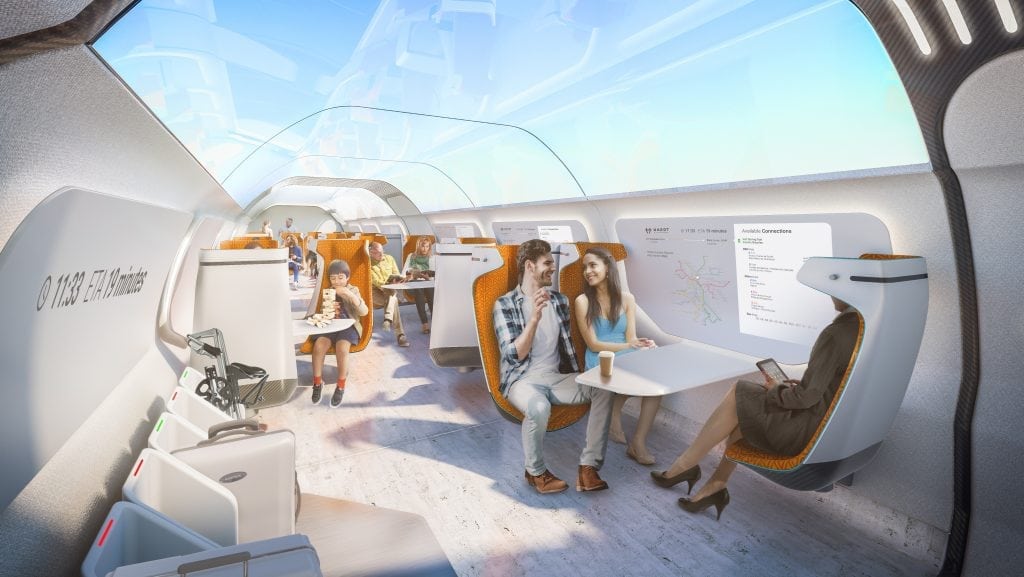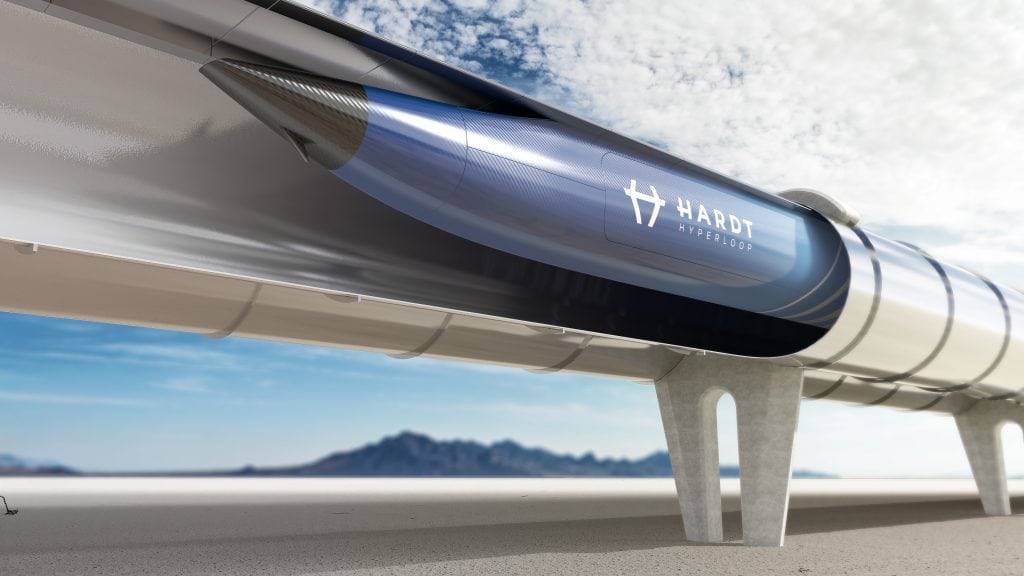Skift Take
The Hyperloop system may seem far off in the future, but the reality is that some outlandish concepts are getting closer to the mainstream. What does this mean for the airline industry going forward?
This sponsored content was created in collaboration with a Skift partner.
This article is part one of two in The Vanguard of Kinesis, a series exploring the autonomous and high-speed future of short haul transport. This series is sponsored by CarTrawler.
The need to travel as fast as we tweet has never been more necessary as the world shrinks under the weight of instant communication, a 24-hour news cycle, and the immediate dissemination of information through the multitude of different mediums at our fingertips.
The idea of putting commuters in a levitating pod and firing them at high speed through a long pipe may seem like a preposterous notion –– but placing travelers in a metal tube with wings and shooting them into the air was just as outlandish in the 19th century. When industry leaders like Elon Musk and Uber CEO Dara Khosrowshahi are having a public tit-for-tat over the benefits of flying cars versus 700 miles per hour levitating pods, it’s clear that the race is on to roll out the next step in transport solutions.
Short haul transport will undoubtedly have consequences for airlines operating routes in areas served by the system if adopted for passenger travel. Creating a cheaper and faster alternative to air travel could entirely devastate short haul operators and damage the periphery industries that are dependent on them.
The Hyperloop
The Hyperloop system is one piece of technology with the potential to be greatly disruptive if developed in key locations linking cities that have a high volume of air traffic. It was dreamed up by the team at Elon Musk’s SpaceX and revealed to the world in a white paper penned by the business magnate, titled Hyperloop Alpha, in which he described the proposed system as “a new mode of transport” which seeks to be “both fast and inexpensive for people and goods.”
Musk has envisioned a high-speed pod that rests on a bed of air which is pushed under the vessel by an electric compressor fan in the shuttle’s nose. Traveling on an air cushion, like a puck on an air hockey table, will allow the pod to travel at high speed through a tube without creating friction. “Air bearings, which use the same basic principle as an air hockey table, have been demonstrated to work at speeds of Mach 1.1 with very low friction,” said Musk in his white paper.
In order to get around the prospect of battery power aboard the pod, external linear electric motors placed along the pipe powered by overhead solar panels have been proposed. These are required for less than 1 percent of the tube length, making powering the Hyperloop particularly cost effective, despite the rather sizable outlay costs, which are estimated to be around $6 billion in the white paper.
The Hyperloop’s Possible Impact on the Airline Industry in Dollars
This new technology poses questions for the airline industry, as just one functional Hyperloop could have detrimental disruptive effects on airline revenues. Take the San Francisco International Airport to Los Angeles International Airport route as an example, which caters to more than 2.2 million annual passengers paying an average base fare of about $112 each, according to International Airport Review. A Hyperloop between the two cities would pose a potential yearly loss of nearly $250 million to the industry in airfares alone, without taking into account the possibility of substantial losses in ancillary revenue. If a long distance Hyperloop between New York’s John. F. Kennedy Airport and Los Angeles International Airport was unveiled before affordable supersonic airborne alternatives were rolled out, the potential loss of more than 2.87 million passengers paying an average of about $338 per person annually would bring the yearly loss to just short of $1 billion.
The Potential for Supersonic Airborne Alternatives
With companies like Boom Technology planning to fly its Boom Supersonic plane from London to New York in three hours and 15 minutes by 2025, this loss may be avoidable. According to reports, there have been 76 orders placed for the Virgin-backed Boom Supersonic jets, which are expected to be airborne within the next six years. Boom Technology CEO Blake Scholl has boasted that they will create “the first supersonic jet people can afford to fly,” with an estimated ticket price of $5,000 from New York to London.
Meanwhile Musk estimated the cost of a seat in a Hyperloop pod to be “$20 for a one-way trip,” based on amortizing the set up cost of $6 billion over 20 years. He admits that the Hyperloop is more fitted to “high traffic city pairs that are less than about 1,500 kilometers or 900 miles apart.” After that point, “supersonic air travel ends up being faster and cheaper,” according to Musk.
This post Concord supersonic rebirth has made it all the way to the White House. The Trump administration’s fiscal year 2019 budget proposal for NASA includes full funding for the Low Boom Flight Demonstrator (LBFD), an experimental supersonic aircraft that could potentially transport commercial-airline passengers faster than the speed of sound. And with a high enough altitude and the right geometry, the sonic boom noise on the ground would be no louder than current airliners.
Hyperloop One
Hyperloop One, the most prominent team working on Musk’s idea, was recently backed and rebranded by Richard Branson’s Virgin Group for an undisclosed sum. This investment was part of an $85 million fundraising push for the now Virgin Hyperloop One team to further its efforts. So far they have built a 1,640 feet (500 meters) tube called the DevLoop on an isolated patch of desert 35 miles north of Las Vegas, Nevada.
The Virgin backed team believes they can launch a commercial system in the U.S. by 2021. So far they have managed to shoot their prototype pod 240 miles per hour (386 kilometers per hour). This shuttle will be for both cargo and passengers, though the team is focusing on cargo as a logical starting point. “We plan to have a single type of pod that can do both cargo and people,” said Anita Sengupta, senior vice president at Hyperloop One, in an interview with Wired.
Hyperloop One claims that they are planning to start by moving containers back and forth from the ports of Los Angeles, which they say will help to remove trucks from congested urban areas.
Virgin Hyperloop
Richard Branson announced the Indian State of Maharashtra’s intent to build a Virgin Hyperloop in February 2018. According to reports, the proposed Hyperloop route will link central Pune, Navi Mumbai International Airport, to Mumbai in 25 minutes, connecting 26 million people. Supporting 150 million passenger trips per year, it would help create a thriving, competitive megaregion. Branson announced that their studies have found that the Pune-Mumbai route has the potential to drum up $55 billion in socioeconomic benefits, time savings, accident reduction, and operational cost savings, while also reducing greenhouse gas emissions up to 86,000 tons over 30 years of operation.
Virgin also recently unveiled their new pod prototype for the Dubai to Abu Dhabi Hyperloop, which will allegedly hit speeds up to 760 miles per hour (1,200 kilometers per hour), making the 90 minute car journey in only 12 minutes. The big reveal for the luxurious low friction passenger pod was part of the United Arab Emirates’ Innovation Month, which has become a cutting edge transport showcase since Dubai’s Road Transport Authority (RTA) announced that 25 percent of all journeys are to be driverless by 2030.
Hardt Hyperloop
Musk’s concept and white paper focuses on a journey between the Californian cities of San Francisco and Los Angeles, but a team based in the Netherlands is spearheading Europe’s first Hyperloop experiment. Hardt Hyperloop emerged from Delft Hyperloop, the team from the Delft University of Technology in South Holland Province, Netherlands, that won Elon Musk’s 2017 Hyperloop competition. They are supported by the Royal BAM Construction Group, Dutch Railways, and Delft University of Technology and UNIIQ, an investment fund focused on the proof-of-concept phase.
In December 2017, the Dutch House of Representatives voted unanimously to investigate the financing of a high-speed test facility for the Hyperloop in Flevoland, in cooperation with Hardt Hyperloop and other private parties. “It’s great to see that the opportunities offered by the Hyperloop are now also acknowledged by politicians,” said Tim Houter, CEO and co-founder of Hardt Hyperloop. “Things are going in the right direction.”
The Dutch team has developed “the first low-speed test facility in the Netherlands,” according to Hardt Hyperloop’s head of marketing Jelte Altena, while also securing an initial financing round of about $155 million (1.25 million euros). “In collaborations with our partners, we have been able to expand our field of activity and develop and test new technology and theory.”
Hardt Hyperloop, collaborating with the Dutch Government, is planning to develop a high-speed test facility in the Netherlands which, according to Altena, “would create 400 jobs and set the standard for Hyperloop technology.” Hardt’s timeline is a little more realistic than some of its competitors, as the Dutch team plans to have its first commercial route, which, according to the team, will be “super safe, durable, timesaving, and energy efficient in 10 years.” However, for now the team is “focusing on developing an international standard so that the idea can be implemented effectively and safely throughout the world.”
The Hyperloop system is likely going to majorly disrupt airline operating routes if and when it reaches consumer travel. A cheaper and faster alternative to air travel could totally damage short haul operators and the periphery industries surrounding them. However, it will be decades until this system is fully adopted, provided it is proven to be safe, secure, and cost effective, giving the airline industry time to adapt as long as providers remain abreast of the developments.
The next installment of the series examines the future of short haul transport and the rapidly evolving world of autonomous drones, their practical uses, their limitations, and how the airline industry can capitalize on their development.
Article by: Morgan Flanagan Creagh
This content was created by CarTrawler and published by Skift’s branded content studio SkiftX.
Have a confidential tip for Skift? Get in touch
Tags: cartrawler, hyperloop, transport



